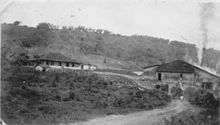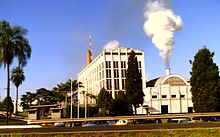Sugar industry in Brazil
Brazil has a long tradition of growing sugar cane. In 1625, all of the imported sugar in Europe came from Brazil. Today, Brazil is by far the largest producer of sugar cane in the world.
Overview
About 85% of all sugar cane cultivation is concentrated in the states of São Paulo and Paraná. The area under cultivation is around 5.6 million hectares (2004).
In Brazil, however, not only is sugar made from sugar cane, the production of bioethanol is also noteworthy. With an output of 40 million m³ (2004), Brazil ranks second in the world in bioethanol production behind the USA . In 2007, the sugar cane harvest in Brazil was 558 million tonnes, a growth of 17.62% compared to 2006. The forecast for 2008 is 607 million Tons of which 89% (540 million tons) are used for the production of sugar and ethanol, the other 11% are used for the production of cachaça , amorphous sugar (rapadura), as fodder and as seeds.
It is estimated that sugar cane production in Brazil will grow to around 1.05 billion tons by 2020.
criticism
Low wages for farm workers and low requirements for environmental protection, e.g. For example, the lack of sewage treatment plants for the water that occurs during sugar production, in addition to the favorable climate, contribute to the fact that Brazilian cane sugar can be offered cheaply on the world market. In addition, primeval forests are cleared for sugar cane production, e.g. B. in the world's largest wetland, the Pantanal, with negative consequences for the local ecosystems .
Sugar export
With an export of 17.7 million tonnes (2005–2006) and a share of almost 40% of the world's sugar exports, Brazil is the world's largest sugar exporter. The EU follows by a long way in second place with 8.1 million tonnes, although this share is falling as the WTO has forced the EU to limit subsidized sugar exports to 4.1 million tonnes per year.
Most of the sugar exported from Brazil is so-called VHP sugar (“very high pol (arity)”), ie raw sugar that contains only a few non-sugar components. Although this sugar generally still has to be refined in the country of destination, the refining process produces only a few waste materials compared to "normal" raw sugar, so that the refining of the VHP sugar is very efficient.
Electricity from sugar cane bagasse
The sucrose only makes up a little more than 30% of the chemical energy that is stored in the ripe sugar cane plant. 35% is contained in the leaves that are left in the field when harvested, and 35% is contained in the bagasse that is left after the sugar juice is squeezed out.
Some of the bagasse is burned in the sugar factory to produce thermal energy for sugar production and distillation as well as electrical energy for the machines. As a result, sugar cane mills are energetically self-sufficient and they are even able to sell excess electricity to utility companies. With a generation of around 600 MW for self-consumption, around 100 MW can be generated for the public grid.
The energy suppliers are happy to use it, as it is mainly generated in the dry season, when the level in the Brazilian reservoirs is low and the generation from hydropower is low. Estimates of the potential power generation range from 1,000 to 9,000 MW, depending on the technology used. The higher estimates are based on the gasification of the biomass, the replacement of the currently used low-pressure steam boilers and turbines with high-pressure boilers and turbines, and the use of the biomass currently left on the fields in the form of leaves. In comparison, the Angra I nuclear power plant in Brazil produces 657 MW.
It is currently profitable to generate around 288 MJ of electricity per ton of sugar cane from the waste products of alcohol production. About 180 MJ of this is used in the factory itself. In this respect, a medium-sized sugar factory could sell around 5 MW of electricity. At current prices, the factory's revenue is approximately US $ 18 million from sales of sugar and alcohol and an additional US $ 1 million from sales of excess electrical energy. With advanced technology in boilers and turbines, the yield could be increased to around 648 MJ per tonne of sugar cane, but at current prices the investments are not profitable.
Burning bagasse is environmentally friendly compared to other fuels such as coal and petroleum . The ash content is only 2.5% (coal: 30–50%) and it contains no sulfur . Since the combustion takes place at relatively low temperatures, little nitrogen oxides are produced.
In Brazil, bagasse is used in several industries to replace petroleum as a fuel. In the state of São Paulo alone, 2 million tons are used annually, saving US $ 35 million in oil imports.
Web links
- The Brazilian Sugar Industry USDA Document September 2001 (PDF file; 54 kB)
- Terra Brasil - bioethanol in Brazil
- Energy from Sugar-Cane Bagasse - a computable model ( Memento from October 1, 2006 in the Internet Archive ) (PDF file; 54 kB)
- Brazil - schnapps in the tank, ARTE report from January 18, 2006
- In Brazil, sugar cane plantations are driving out small farmers
Individual evidence
- ↑ Latin American Studies ( Memento of the original from February 18, 2015 in the Internet Archive ) Info: The archive link has been inserted automatically and has not yet been checked. Please check the original and archive link according to the instructions and then remove this notice. .
- ↑ Bioethanol as a Fuel - Status and Perspectives by Norbert Schmitz, April 2006 .
- ↑ Folha Online - Dinheiro - Produção de álcool e de açúcar baterá recorde em 2008, prevê Conab - 29/04/2008 .
- ^ Sugar Journal, July 2010, p. 20.
- ^ Agriculture in Brazil - A field report from November 22nd to December 6th, 2003 .
- ^ Brazilian Sugar Export, January 18, 2017 ( Memento from September 21, 2012 in the Internet Archive ).

